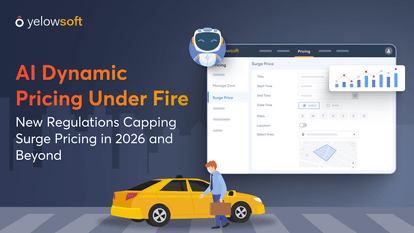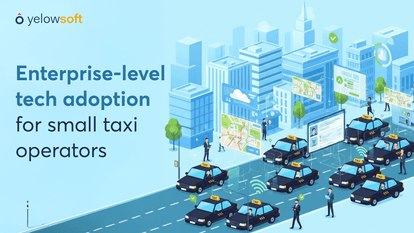Scheduled rides are not just about showing up. They are about showing up exactly on time, every single time. Whether it is a business class airport pickup at 8 PM or a daily 6:30 AM hotel transfer, precision is everything.
Still, many fleet operators depend on manual coordination or generic tools that are not built for the unique needs of scheduled bookings. This often leads to one result: inconsistency.
A major shift is taking place in the ground transport industry. Companies are now adopting an auto dispatch system for scheduled rides that relies on predictive scheduling software to boost reliability and eliminate dispatch confusion. This approach is no longer optional. It is fast becoming the standard for professional fleet management.
In this blog, you will learn how automated dispatching software is streamlining scheduled operations, what logic powers these systems, and how AI based dispatch software can bring greater control, fairness, and efficiency to your business.
Let us break it down step by step and see why this matters more than ever if you are running or scaling a scheduled ride operation.
What Is an Auto Dispatch System for Scheduled Rides?
An auto dispatch system for scheduled rides is an intelligent mechanism that automatically matches drivers with pre-booked trips based on real-time availability, historical data, and operational logic. Unlike systems designed for on-demand rides, this one focuses on predictability, not urgency.
Think of it as a digital dispatcher that always knows which driver is best suited for a job — not just who is free, but who is most reliable for that time, location, and vehicle type.
At its core, the system combines predictive scheduling software with built-in rules like proximity, vehicle tags, time slots, and even fallback logic. This helps ensure every airport pickup or morning corporate ride goes off smoothly, without the constant back-and-forth of manual assignment.
Fleet managers who use automated dispatching software for scheduled rides often report fewer delays, better driver distribution, and higher customer satisfaction.
Now that you know what an auto dispatch system really is, let’s look under the hood.
Dispatch Logic Flow
A smart system is only as good as the logic it runs on. This section breaks down how a modern automated dispatching software makes every scheduled ride assignment feel seamless and predictable.
Let’s explore each layer of the dispatching mechanism.
Driver Eligibility
First, the system filters out drivers who are not a good fit for the upcoming trip. Only those who meet these conditions are considered:
- They are online or scheduled to work within the trip’s time window
- Their vehicle and service tags match the booking (for example, MPV or business class)
- They are not already handling another conflicting job
- They are located within the dispatchable radius of the pickup point
This early filtering ensures the auto dispatch system for scheduled rides only works with valid, real-time options — saving time and reducing misassignments.
Proximity-Based Priority
Next, the system applies proximity logic, but with context. It does not just look at who is nearby right now. Instead, it also checks:
- Where the driver is likely to complete their current trip
- How close that drop-off location is to the upcoming pickup
This makes predictive scheduling software more accurate than basic GPS tracking. It considers where a driver will be, not just where they are.
That means fewer delays and better transition between rides, especially in busy zones like airports or event venues.
Historical Availability Matching
Here is where the system starts acting smart.
It looks back at the last 15 days (or a custom period) and checks which drivers are consistently present in the pickup zone at that same time of day.
This boosts reliability. If a driver has been online and available near the hotel at 6:30 AM for the last two weeks, the system knows they are a better fit than someone who just happens to be nearby once.
This is what sets the best software for predictive ride scheduling apart. It does not just guess — it learns patterns.
Fallback and Fail-Safe Handling
Even the best plans need a backup. That is why intelligent dispatch includes:
- A soft retry cycle if the top-ranked driver does not respond within a set time
- A fallback pool of drivers already filtered and ranked, ready to step in
- A manual override so that dispatchers can take control if needed
As one Reddit fleet operator said, “Most apps fall apart when drivers ghost scheduled jobs. Fallback logic saved us dozens of missed pickups.”
In other words, the fallback layer is not optional — it is critical for consistent service.
Now that the logic is clear, let’s look at how this plays out in real-world operations.
Real-World Use Cases
Understanding the theory is important, but watching it in action makes the value undeniable.
Let’s walk through two practical examples that show how a smart auto dispatch system for scheduled rides solves real business challenges.
Use Case 1: Airport Transfer at 8 PM
Imagine a customer books an MPV for a scheduled airport pickup at 8 PM, Terminal 2. The system immediately gets to work.
- It identifies MPV-tagged drivers who are online or whose shifts align with the 7:30 to 8:30 PM window
- Among them, it prioritizes drivers likely to complete a nearby trip around 7:45 PM
- It checks historical presence — who usually operates in that zone at 8 PM
- It then applies job distribution rules to avoid assigning the same driver too often
- Finally, it creates a ranked list and begins soft-assigning
If the top driver does not respond, fallback candidates step in. Thanks to predictive scheduling software, the system anticipates rather than reacts, reducing last-minute panic.
Use Case 2: Early Morning Corporate Pickup
Now consider a VIP who expects a Business-Class vehicle daily at 6:30 AM from a hotel to the business district.
Here’s what the automated dispatching software does:
- At 6:00 AM, it filters Business-Class drivers scheduled to be online by 6:15
- Then it checks which drivers usually start their day near the hotel zone
- It favors those with fewer jobs that day to maintain fairness
- A soft assignment goes out to the top driver with a 15-minute lead
- If no response, the system activates the fallback list
This type of scheduled precision is not possible without a deeply tuned, AI based dispatch software that understands patterns and adapts in real-time.
And here’s the result: The ride shows up on time, the driver is confident, and the client never has to wait.
Now that you have seen how it works in real life, let’s talk about how AI takes this to the next level.
The Role of AI in Smart Dispatching
Yes, and that is where AI based dispatch software plays a crucial role. Artificial intelligence adds a predictive and performance-driven edge to your dispatching, ensuring the system is not just automated but also adaptive.
Let us break down how AI transforms dispatch logic into a powerful, evolving ecosystem.
1. Predictive Dispatch Engine
At the heart of every smart dispatch system is a model that predicts driver behavior before it happens.
Using machine learning, the predictive scheduling software analyzes:
- Driver availability patterns
- Likelihood of job acceptance
- Accuracy of ETA predictions
- Impact of time of day and trip type
If a driver usually declines long-distance trips after 8 PM or often runs late during peak hours, the system factors that into the assignment logic.
That means fewer failed matches and more reliable dispatch outcomes.
And in use cases like airport drop-offs, that predictive power directly impacts customer satisfaction.
A recent Accenture report noted that AI-based scheduling systems improve operational accuracy by up to 25 percent in transport services. That kind of uplift can translate into dozens of successful trips per week for mid-sized fleets.
2. AI-Enabled Tracking and Monitoring Driver Performance
Automation without accountability does not work.
That is why the best systems include AI-enabled tracking and monitoring driver performance. They track each driver’s:
- Acceptance rate
- On-time arrival percentage
- Completed jobs vs. canceled ones
- Customer feedback trends
Based on these inputs, the system assigns a dynamic performance score that feeds directly into dispatch decisions.
So, drivers who are consistently reliable are prioritized. Those with spotty history still have a chance — but not at the cost of your service quality.
This performance-driven logic makes your dispatch feel fair and efficient while aligning with your brand’s service promise.
3. Real-Time Delay Prediction and Reallocation
Scheduled rides depend on accuracy. But traffic, weather, or unpredictable delays still happen.
This is where AI based dispatch software truly shines.
It monitors ongoing trips in real time and uses historical trends plus live GPS data to predict whether a driver will be late. If a delay seems likely, the system proactively reallocates the upcoming job to a fallback driver — before the customer even realizes there is a problem.
This helps reduce no-shows and late arrivals, especially for critical bookings like business pickups or hotel-to-airport transfers.
By combining logic, automation, and adaptive intelligence, AI gives you the edge to stay ahead of delays, disruptions, and declining service quality.
Let’s now wrap this up and highlight why this approach is essential for modern-day fleet operators.
Conclusion
Scheduled rides are all about trust. Whether it is a daily corporate pickup or an airport transfer, showing up on time builds customer loyalty.
A modern auto dispatch system for scheduled rides takes the guesswork out of assignments and replaces it with intelligence, fairness, and reliability.
With the help of predictive scheduling software, automated dispatching software, and AI-enabled tracking and monitoring driver performance, fleet operators can finally scale without losing control.
If your dispatch process still depends on manual coordination, now is the time to rethink. Smart dispatch is no longer a nice-to-have — it is a must.
Automate Your Dispatch Mechanism For Schedule Rides With Yelowsoft




